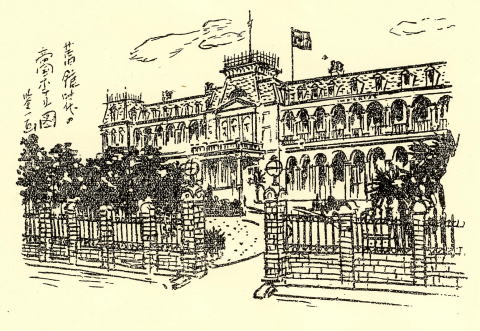
The imperial Hotel in olden
days
(by Kenichi)
|
帝国ホテル出入商人用門鑑
Trade Pass for the Imperial Hotel
|
アルバイト学生を苦学生と言っていた頃の大正四、五年からこの話は始まる。
私もその苦学生として、東京芸術大学の前身で親しみ深い東京美術学校在学中であった。紙商の老舗(和紙のはいばら)はその頃帝国ホテルの御用商をしていた)からの急な呼び出しで、帝国ホテルの食堂壁画をやってみないかとの話だ、苦学生でなくたって発奮出来る仕事だから私は大いに感激、早速時の支配人であった林愛作氏に面会する為に出かける事にした。 |
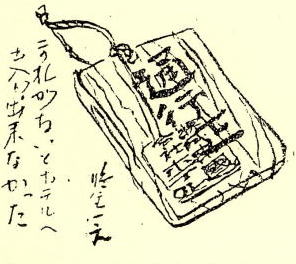 そして同商店員に付添われて、山下橋側入り口から参入する事になった。とその時同行の店員の右手に何か木の札が見えるので 「それは何か」と聞きただすと 「これがないとホテルへ入れないのだ」と云うのである。 そして同商店員に付添われて、山下橋側入り口から参入する事になった。とその時同行の店員の右手に何か木の札が見えるので 「それは何か」と聞きただすと 「これがないとホテルへ入れないのだ」と云うのである。
出入商人用門鑑なのだ。三、四寸平方の木札で株式会社帝国ホテルと焼印で捺されてある通行証なので手垢で汚れた時代物である。当時のホテルが如何に封建的であったかが伺われよう 赤煉瓦と鉄柵で囲まれた前庭から中央玄関までの登り道の重々しい感じと来たら、我々苦学生にとっては全く以って性に会わない、今新館建築中のところが全部前庭であった。
Without this plate, no one could enter the hotel
.Sketch
by Kenichi |
These episodes took place in 1915 - 1916, when self-supporting students were called ‘struggling students’.
I was one of those struggling students, studying at
the Tokyo School of Fine Arts, now known as Tokyo University of Arts. Haibara, a Japanese paper specialist of long
standing and a purveyor of the Imperial Hotel back then, called me up and asked
if I was interested in painting a mural in the dining room at the Imperial
Hotel. As it was an extraordinary offer
for anyone, let alone a struggling student, I immediately went to see Aisaku
Hayashi, the then hotel manager, feeling gladdened.
I
approached the hotel entrance on Yamashita-bridge side, accompanied by a
Haibara’s shop assistant. I noticed him
holding a wooden plate in his hand and so asked him what it was. He said to me ‘No one is allowed into the
hotel without this.’ It was the entry
pass for the traders. ‘Imperial Hotel,
Co. Ltd.’ was branded on the 3-4 square inch wooden plate. Having been used as a pass for some time, it
was covered with fingermarks as if to show off its history. It
tells you how conservative the hotels were back then.
The
upward slope through the front garden, enclosed by the fence made of red bricks
and iron, led to the main entrance was very stately and made me, a struggling
student, feel completely out of place.
The area where the new annex is currently being built was all part of
the front garden. |
林愛作
Aisaku Hayashi |
今日は、付添人任せの事だから、少しは気軽だ、入口のドアーを押して入るとドアーマンの妙な応揚さを横目で通過、ページボーイの案内で悠々林さんの室に導かれた、其処に大きなデスクに向かってた和服姿、一寸小柄な身を向きなおして、「まあ腰をかけなさい」と云われ眼がヒドク物を云いそうな、グリとした眼の鼻下に短い口髭をつけた垢抜けした紳士であった、四十前後を感じさせる、一応仕事に対する希望、その他割合に物解りの早い話で会見を終えて現場を見てくれというから、こちらもその方が好ましいから、すぐに同道した。
そこは全館の中央部にあたる食堂の南隣に新食堂を増築した、その上部にある欄間へ現代の東海道五十三次を画いてくれという希望なのだ。旧食堂には、すでに五十三次を広重風の東海道が画かれて、少し時代色がついていた。
ここで私はよし、それなら東海道を写生旅行しても、この仕事をやり上げ様と腹が定まってので直ちに快諾、大体の壁画を計ると高さ約三尺二、三寸、横は全長廿五、六間、つまり百五十尺位になるのだから相当なものである。 |
The thought that I could leave everything to the shop assistant who accompanied
made me feel somewhat easier. I push-opened
the entrance door, passed by an oddly nonchalant door-boy, and then calmly
followed the pageboy to Mr Hayashi’s office.
He was dressed in a kimono and sat at a large desk. Turning his rather small body to us, he said
‘Take a seat’.
He
seemed to be a sophisticated gentleman of about 40 years of age, with a pair of
extremely expressive eyes and short moustache.
After asking me about my expectations with the job and some other straightforward
questions, he ended the meeting and suggested that I should have a look at the
site. I immediately agreed to it, as
that was preferable to me, too, and followed him to the site.
The
site was the new dining room built onto the south side of the existing dining
room which was located in the centre of the main building. The briefing was to paint the modern version
of the ‘Fifty-stages of Tokaido’ mural, on the balustrade which are built in a
high up position of the dining room. In
the existing dining room, there was already a Hiroshige-esque ‘Fifty-stages…’
painting, which looked a little dated.
I made
the decision there and then to take on the commission, even if it meant that I
needed to go on a sketching tour along the Tokaido (ancient Tokyo-Kyoto
highway), and duly accepted the offer. I measured the size of the mural space and realised it was huge - 3 feet
2-3 inches in height and 150 feet in width. |
帝国ホテル第一印象
First impression of the Imperial Hotel
|
ロビーでお茶とケーキを接待され、食堂をもう一度見直して考想していると、ふと玄関のほうを見ると、フロント受付で事務をとって居られた人が後で解ったのだが現社長の犬丸さんど富森さんであった。又食堂主任の岩佐さんに会ったり、宴会の事務所では、林愛作さんがワインカップの良し悪しを透かし見ては、悪い分をそのまま屑箱の中にガチャンガチャンと捨てて、壊してしまうので苦学生の胸を驚かせた等々、ホテルの裏表を少し味わったのが三十年前の帝国ホテル第一印象感である。
|
| We
were treated to tea and cake in the foyer where I started pondering about the
dining room. Looking to the front desk, I saw two people doing some office work - Mr
Tomimori and Mr Inumaru, who I later realised is the current president
of the hotel. I also met Mr Iwasa, the head of the dining department. In the Banquet Room office, I witnessed Mr. Aisaku Hyashi checking wine
glasses through light and crashing the poor-quality ones into the bin,
which astonished the ‘struggling student’.
These behind-the-scene memories made up my first impression of the
Imperial Hotel some 30 years ago |
出で立ち
Departure |
さて、五月も末のそろそろ初夏の風が吹く頃、学校の方は好い加減にして東海道は絵行脚に先ず榛原商店主に後援を願って、金二百円也(当時の金額としては大金)を前借の上悠々東海道は京を目指して初絵の旅に出る。時に二十三歳の青春であった。
ところがいよいよ出発と云う前日になると持病の急性扁桃腺炎が始まった。鏡でみると喉がすっかり赤くなっている、ここまで来た機会を今更延ばすのは残念だ、若さも手伝って、兎に角東京駅から藤沢目指して汽車に乗る。(藤沢迄は二三回日帰りでスケッチしておいたから)
大正の絵膝栗毛よろしくの出で立ちに付いて一寸ご紹介して置く、先ず下の方から新調の大鋲付の軍靴まがい黒靴と、ゲートル海軍形黒ラシャ製、綿製のコウモリ傘、大画帖を五六冊と、雨用コートを一括りにした革バンド、手提げ、三脚、肩からは画板を掛けて、中古学生服と、まあ以上の様な身構えであった。
|
Around
the end of May, when the early summer breeze was just about to arrive, I first asked
the owner of Haibara for supporting the sketching trip and borrowed 200 yen (a
large sum back then). With the
attendance at the art classes no longer a priority, I readied myself to set
off, in high spirit, for the sketching trip along the Tokaido from Tokyo to
Kyoto. I was 23 years old and at the
midst of my youth.
However,
the night before the departure, I succumbed to acute tonsillitis which I had
been subject to. In the mirror, my throat
looked red and swollen. However, I felt
it was a shame to postpone this challenge at this stage. Partly due to youthful enthusiasm, I somehow
embarked on the train from Tokyo to Fujisawa (as I had already made a couple of
day sketching trips to that point).
I’m
going to briefly describe my travelling attire, which I fancied myself as a
character in an artist’s version of ‘Tokaido Hizakurige’ (A famous comic
travelogue from Edo period). From the
shoes upwards; a new pair of black quasi-army boots with large studs, marine-style black
wool gaiters, cotton umbrella, 5-6 large sketchbooks, raincoat bound by
a leather belt, briefcase, tripod, a drawing board hanging on a shoulder
and pre-owned school uniform with stand-up collar |
平塚の友人其の一
A friend in Hiratsuka (Part 1) |
正午近く藤沢駅下車、旧東海道へ出る。六月の太陽はたださえ強いのに半病人のとっとは相当にこたえる。傘を差してもまだつらい、唾を飲むのも痛い、それでもやっと茅ヶ崎迄は歩いたがスケッチも出来ない、ここで平塚迄の第一日行程を急に汽車に変更、始めから予定して居た友人で我がパトロンの別荘に向かった。
S君と云う平塚町(当時は町)一番のブルジョアーで平塚の西海岸唯一の別荘に着いたのは夕方近かった。
何しろ無理をした一日だけに疲れも出たから早めに寝る事にした、まだ喉は痛む、神様明日は直して呉れよと祈る最上等の布団に包まって。
|
I got
off the train at Hiratsuka station just before the noon, and headed for the old
Tokaido road. The sunshine in June is
strong and felt particularly punishing for me in poor health. I shielded the sunlight with my umbrella, but it was still intense, and
my throat was sore even to swallow saliva.
I somehow managed to reach
Chigasaki on foot, but sketching was out of question. So, I changed the plan for the first leg of the
journey to Hiratsuka, and used the train instead of walking, and went to a holiday
villa of my friend who was also my patron.
It was almost
early evening by the time I arrived at the villa of Mr S, who was from the most
affluent family in Hiratsuka town (now a city). It was the only holiday villa
on the west Hiratsuka coast back then.
I was
tired, having pushed myself too hard all day, and so went to bed early. The throat was still sore. I prayed for a better day and lied down on
the most luxurious futon.
|
平塚の友人其の二
A friend in Hiratsuka (Part 2) |
翌朝は松に吹く風の音と波の音に眼が覚める。六尺幅の大きな縁の南側ガラス戸のカーテンを開いて旅の第一夜から起床見渡せば、小松の密生した林に囲まれたこの家は砂丘と松と桃の織り成すウネリの地形中に何処までが邸内なのか解らない、西方を見れば霊峰富士の頂上が箱根の右に松越しに見えて相模湾の雄大さがコバルト色に光っている全くこれはたいした場所だ。
爺やと二人暮らしのS君は物静かな人物で私の画を展覧会から買い上げてくれて以来の交友である。
朝食を二人で摂る、どうした事か喉の痛みを忘れている、そこで又も鏡に映してみると、赤みが少し消えて居る。海気を呼ぶこの地辺の空気が自然と吸入器の役目をしたのだろう。元気が付いたので急に出発を思い立つ、S君はもう一日延ばしたらと言ってくれる、断る、では箱根まで一緒に行きたい、よろしい、二人連れの旅路になって、出発した。
|
After the
first night of the journey, I awoke to the sounds of wind passing through pine
trees and waves hitting the shore. I
opened the curtains across the south-facing 6 feet across, wide-rimmed sliding
glass doors, and looked outside. The
house was surrounded by the dense copse of young pines. The ground was made up of undulating dunes
and peach trees and it was hard to tell where the boundary of the property was.
Looking to the west, the peak of Mt. Fuji, the sacred mountain, was visible on
the right-hand side over the pine trees, and the vast Sagami bay water was
glistening in cobalt blue. It was an
amazing place.
Mr S, who lived with an old handy-man, was a quiet
man, and we had been friends since he bought my painting at an exhibition.
We had
breakfast together. I realised that I no
longer had a sore throat and discovered that the tonsils didn’t look so red any
more. The air in this area where the sea
breeze pass through must have worked as a kind of inhaler. Feeling much more energetic, I decided to
continue the journey. Mr S suggested to
delay the departure for another day, but I declined. He then asked me if he could join me for the next
leg of journey to Hakone. So, that was
how I came to depart with a travel companion. |
大磯名物粧団子
Mekashi dango -
Oiso’s local delicacy |
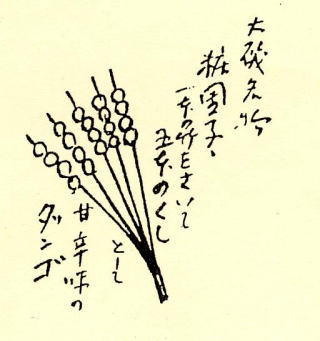 平塚はずれの花水川に映る高麗山の緑の美しさ、大磯の虎と関連の深い粧阪(けはい)にかかる、昨年まで東海道線と交差していた踏切のすぐ右手、昇りきった右側に、一軒の茶店があった。ここの団子が美味しいからと云うので腰を下ろす、成程一寸はいけるが味より形が面白いので印象に残る。最もこれは東京でも見た事があるが、それよりも極めて小さい団子で五本の串に集めて焼いたものその名も粧団子と呼んでいた。(カット参照) この家は今も残っているのが汽車の窓からよく見える。勿論今は茶店ではないし代も変わっているだろう。 平塚はずれの花水川に映る高麗山の緑の美しさ、大磯の虎と関連の深い粧阪(けはい)にかかる、昨年まで東海道線と交差していた踏切のすぐ右手、昇りきった右側に、一軒の茶店があった。ここの団子が美味しいからと云うので腰を下ろす、成程一寸はいけるが味より形が面白いので印象に残る。最もこれは東京でも見た事があるが、それよりも極めて小さい団子で五本の串に集めて焼いたものその名も粧団子と呼んでいた。(カット参照) この家は今も残っているのが汽車の窓からよく見える。勿論今は茶店ではないし代も変わっているだろう。
大磯では鴨立澤その他紹介され尽くされているから一とびに小田原に話をうつす。
Local delicacy of Oiso - Mekashi dango
Sweetened soy-sauce flovoured dumplings skewered through
a bamboo stick split into five |
Kewai is the slope associated with the beauty of the greenery of Mt. Komayama reflected on the River Hanamigawa that flows through the edge of Hiratsuka, and the Tora of Oiso (a historical
character). There was a tea house at the
top of the slope on the right-hand side of the level crossing which had
intersected with the Tokaido railway until last year. We stopped there as we had been told that
their dango (skewered dumplings) were
good. Indeed, they tasted rather good
but actually it was the shape that was more interesting and impressive. I had seen similar ones in Tokyo but these
dumplings were much smaller. These
dumplings named ‘Mekashi dango’ were
skewered through a bamboo stick split into five sticks on one end and then
grilled. (See sketch)
This
building is still there and visible from the trains. It’s no longer a teahouse and probably is in
hands of a later generation.
Oiso is
already widely known through the poem about Shigitatsu-sawa
and so on, and I will skip this stage and move this travelogue straight to
Odawara.
|
小田原外朗透頂香(ういらうとうちんかう)
Odawara Uiro Tochinko |
この小田原ではその頃特異な存在として、箱根に掛かる直線になったところの町並みにあった外朗透頂香(ういらうとうちんかう)の店造りであった、これは薬舗だが八棟の天守閣に似た店の造りが白漆喰仕上げでその棟が三つ並んでいた屋根の勾配とその棟のカーブから来る不思議な感覚が昔箱根を越えてくる人々の眼をどの位掴んだ事であろう、思いつきもさることながら中々宣伝的にも効果100%だ。古本の東海道名所図絵五の巻に記録されてある文に曰く
「小田原外朗透頂香は大覚禅師来朝の時より日本に伝わり北条氏綱ここに在城の時八棟造りの薬店 を許して弘めさせけり」
とある。不幸この歴史的な建築物も大正の震災で消えていったのである。
|
| In Odawara,
there was one store premise of Uiro
Tochinko, that stood out of the townscape on the straight stretch of the Tokaido
highway towards Hakone. This herbal
medicine manufacturer occupied three connected buildings, each of them looking
like an 8-ridged castle tower with stucco walls. The angle of the roofs and the curve of the
ridges gave the surreal impression and I wondered how attention-grabbing they used
to be for those who had approached Odawara from the mountainous Hakone road in
olden days. It was a great idea and 100%
effective as an advertisement. According
to the description in the second-hand book called ‘Tokaido Scenic Points
Pictorial Map, Vol.5’, ‘Odawara Uiro
Tochinko reached Japan around the time Daikaku Zenji (Lanxi Daolong) arrived in
Korea, and Hojo Ujitsuna, while living in the Odawara Castle, gave permission
for the medicine merchant to occupy 8-ridged rooved buildings for disseminating
their products’.
Unfortunately, these historical buildings perished in the Taisho
Earthquake. |
箱根路前半 箱根越え
The First half of the Hakone Road Following the Hakone Pass |
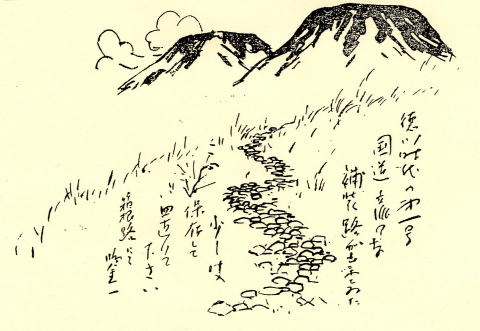
The very first National Road built during Tokugawa Shogunate.
Now tarmacked. I wish they
preserve the original, at least in some area.
On Hakone road, Kenichi |
小田原で一泊した我々は翌早朝箱根へと出発した湯元の三味橋でS君と別れる。箱根越えは元より旧道を味わう事にあるのだ。三味橋でS君は記念の写真を撮ってくれた。 湯元町が裏から眺められるあたりから早川をわたって路は細くなり石畳の昇りにかかる六月というのに老鶯があちらこちらにさえずる、野ばらは芳香を漂わす。初夏の陽はいよいよ強い、緑深い塔ノ沢あたりの木々と早川の流れの音が一人旅となった侘しさをなおさら感じさす。少し行くと南画の泰斗小室翠雲先生の別荘がここにあったのが今だに思い出させる。
畑宿の部落に至るまで全く人に遭わず、畑宿を過ぎて道はいよいよ急となる九十九曲を越え甘酒茶屋あたり双子山の谷間を登り詰めてやっと芦ノ湖が光って見えるところまで来た。
旅は侘しいものといえ、友達と別れてすぐに忘れられたようなこのみちを来たのだから旅愁というものをこれ程強く感じた事は始めてである。だから芦ノ湖が見えて人の住まう元箱根町が見えたこの気持ちはいまだに忘れられない。昔の旧道はこれ程静かであった。
|
After
staying for a night in Odawara, we set off for Hakone and walked together until
splitting up at Sanmaibashi in Yumoto.
The whole point of following the Hakone Pass is to enjoy the old
road. At Sanmaibashi, Mr S took a photo
to remember the day.
As I
passed the area where the town of Yumoto is viewed from the rear and crossed the
River Hayakawa, the road became narrower and turned into an uphill cobbled
path. It was already June, but nightingales were still singing all over the
place and wild roses were giving out flagrance.
The sunlight
in the early summer felt increasingly intense.
The sounds of tree rustling in the lush Tonosawa area and water running
in the River Hayakawa only emphasised the loneliness now that I lost my
travelling companion. I can still remember that further along the road, there
was the villa of Suiun Komuro, the master of the Southern school of Chinese
painting.
I didn’t
encounter anyone at all until I reached the hamlet of Hatajuku. After Hatajuku, the road became really
steep. I passed the Kujukumagari, went
by the Amazake-chaya tea house and followed the ravine between the Futagoyama
hills to the top, until the glistening Lake Ashinoko became visible at long
last.
Solitary
journey is meant to be lonesome. But
travelling along this almost forgotten road immediately after losing the
travelling companion made me more melancholic than ever. The relief I felt when I saw the inhabited
town of Motohakone and Lake Ashinoko is unforgettable. It tells you how quiet the old Tokaido road still
was.
|
元箱根の町
The town of Moto-Hakone |
元箱根の町に入って感じたものは古い山の宿場だという事は勿論だがそれにも増して不思議に思えたのは異国的な香りが強い事だった、ペンキ塗りのスウベニアショップのある事、湖上に浮かぶヨットの形やら、色やら、それにホテルがあった事。看板等に英字が見られる事、等々だ。そこを昔のおもかげそのままの山籠が観光の人を乗せてゆく。古い日本の呼吸と今日の外国の呼吸が打ちかりあって居る山の宿箱根町。
|
| The
first impression of the town of Moto-Hakone was that it looked like, obviously,
an old post town on the mountainous road, but rather strangely, there was quite
an exotic feel about the place, too. Painted souvenir shops, the shapes and
colours of the yachts on the lake, the fact there was a western style hotel,
and English writing on signboards, etc. The sedan chairs that looked exactly the same
as in the olden days, was going by, carrying the tourists. This is the post town in Hakone where the
atmosphere of old Japan clashing with the present foreign influences. |
松坂屋ホテル
Matsuzakaya Hotel |
私はこの矛盾した空気の中に一人ぼっちで着いたんで、懐具合もまだ暖かいので今夜は一つ豪華にホテル泊まりとしよう、こう決めたので町外れにあった松坂屋ホテルの帳場へ入った。
学生服が物を云うこの自信をもって、ところがその頃のホテルと云う看板は今のと異なり立派でしかも、確かなものばかりだったのでバス付の部屋で金五円也にしてもらうまでには中々交渉が難しかった。それに避暑地のことであり時季が来ていた関係もあったからだろう。
ベランダ付ガラス戸の向こうは芦ノ湖だ。少し雲が低いが安楽椅子の木地に彫り物してあるのが、日本製ながら外人趣味を生かして山のホテルらしくよろしい、あいにくこれ等を通して芦ノ湖の景勝が見えないこのベランダで向隅で二人の外人がチェスをやっていて情調深いものがあった。
夕食は勿論食堂でビーフステーキをやったと思う、やがて部屋に戻ってバスには入る。西洋風呂に入ったのはこれが始めてで少し贅沢だなと思う。一人だけ使った湯をそのまま捨ててしまうので、ベットも始めてで寝つき大いに悪かった。
|
Having
arrived in this paradoxical atmosphere all by myself and with quite a lot of
money still intact, I decided to be extravagant and stay at the western style
hotel. I went to the front desk of
Matsuzakaya Hotel which was located on the edge of the town.
I
approached confidently, helped by the power of the University uniform. But the hotels back then were really grand
and upright, unlike those we see these days, and so it was a hard work to haggle
the room tariff for an ensuite room down to 5 yen. It was probably because it was near the peak
season for the summer resort.
In the
room, Lake Ashinoko could be seen at the other side of the balconied glass
doors. The clouds were slightly
low. The wooden armchairs were made in Japan but had some carving that made
them look slightly exotic and suited to the image of a mountain resort. The
picturesque scenery of Lake Ashinoko was unfortunately obscured by these. However, two foreigners were playing chess on
the balcony on the other side, creating an elegant atmosphere.
The dinner was served in the dining, of course, and I think I had a steak. After that, I went back to my room to have a
bath. It was the first time I had a bath
in the western style tub and felt a little extravagant. It seemed wasteful to use the bath water only
for myself. Sleeping on a western style
bed was another first time to me, and I struggled a lot to get to sleep.
|
箱根路後半
The last half of the Hakone Road |
翌朝は少し疲れていたので昼近くここを出ようと思ってロビーまで来ると昨日の外人が今日も又昨日の通りのゲームをしている。聞けばこの外人はドイツ人で軟禁されている非戦闘員だそうだ。なるほどこの頃は第一次世界大戦の最中でそれとなく監視されているとの事だ。
山の空気が急に冷えてきて湖畔の雲は益々深く箱根権現は全く見えない。
勘定をすませ古杉の街道を西へとてくり出す。関所跡にあった一本松の形が心に残る。
暫く行って路は再び上りになる。雲は益々深く密度が濃くなるので一間先がやっと解る位だ心細い限り。馬小唄が聞こえてきてもその姿が見えないまでに過ぎて行ってしまう。道はいつしか下りにかかって依然石畳は続いている。
急に雲が切れた、とそれから見えてきたものは海だ、海岸線だ、畑が、川が、陽も当たっている家が、山が、みんな見える、駿河湾てこれだな、三保の松原はどれだ。この感激、私は暫くスケッチする事すら忘れてこの壮観に見とれていった。
実朝の歌
箱根路を吾越え来れば伊豆の海や
沖の小嶋に波の寄す見ゆ
全くこの通りだ。
右手の雲が切れて富士の横腹が見えて来る。ああもう沢山だ。
これでは絵筆とるどころではない。
こうした状態に引きずられ三嶋の町に午後下って行ったのだ。
水の美しい町、水の豊かな町、しかし沼津への道はせまい、そこを電車が通る。旧道の儘の路巾を通る路線だから歩くのに都合が悪い沼津竹の網代垣が続く、沼津への一里も歩いて駅前の宿に着く。
|
I felt
a little tired next morning and so it was close to the noon by the time I left
the room for the lobby. I noticed there
that the same foreigners were playing the same game as yesterday. Apparently, these were German noncombatants who
had been under house arrest. It was the middle of WWI, come to think of it, and apparently the hotel
was being indirectly monitored.
With air in the mountainous area quickly cooled down and the cloud over
the lake thickened, the Hakone Shrine was completely invisible.
After settling the bill, I headed west following the road flanked by old
Japanese cedars. The shape of the solitary pine tree at the remains of an old checking station
left a strong impression on me.
After a while, the road turned uphill again.
The cloud was becoming increasingly dense and I was just about able to
see 6 feet away and couldn't help feeling uneasy. A drover’s singing voice was audible but
before I was able to see his figure, the singing voice disappeared. I realised that the road, still cobbled, had
started to slope down.
All of
sudden, the clouds disappeared. Then, I
saw the sea, coastline, field, river, the houses in the sun, mountains. Everything became visible. ‘This must be the Suruga bay. Which one is the pine grove of Miho?’ I was
so thrilled that I forgot to make sketches and just admired the magnificent view
for a while
Poem by Minamoto no Sanetomo
Trekked over the Hakone pass
I’ve come
to the coast of Izu
Wave washes the shore of islet
The poem
described it all.
The clouds
on the right-hand side broke and the side of Mt. Fuji became visible. It was almost too much to take in.
There was too much to paint - that was how I was feeling as I descended
to the town of Mishima.
A town of clear and abundant water.
The road that lead to Numazu was narrow, and trams passed by on top of that
narrow road. In fact, the tracks were
laid on the road which had kept the original width and made it difficult to
walk on. I walked for about 2.5 miles to
Numazu following the road bordered by Ajiro-style wicker fences, made of the
bamboo from Numazu, until I reached the inn near the station.
|
沼津の宿
An inn at Numazu
|
帳場の土間で番頭が一通り私を上から下まで眺めた挙句、貧乏絵描きの書生と感じたんだろうご案内と云う掛け声で通された部屋は階段すぐ側にあった離れ部屋だった。こうしてぽつねんと座ってみると今夜の宿は少々寂しい、昨夜の宿の豪華さに引き換えて天地の相違だ勿論山の上と下だからとまああきらめて早寝だ、駅前なのでいろんな雑音が睡眠をさえぎる寝付かれない、夜具の垢染みがが目に付きだす、気持ちが悪い、その上に腰の辺りやその他、体の所々がむずいて来た。
元来私は蚤を憎む事甚だしく事至らば素手で体中の何処の奴でも人差し指と親指で捕まえてしまふのだ蚤取りの名人ながら今夜の奴には参ってしまった。
出て来る出て来る捕まえども、後続が絶えない、記憶はないがこの部屋の分はある程度取り尽したと思えるほど、お陰で徹夜に近い努力をしたから翌朝の目覚めの悪い事、部屋の様子をよく見るとどうも布団部屋であったらしいのだ。
学生の身分には相当して居るのだろうお値段にも関係があってのことだから仕方がない。以後絶対に駅前には泊まらない事にする。
注(この部屋は後年ここを訪ねたときになくなっていて沼津軒とか云う食堂に変わっていた)
|
The
manager examined me from head to toe, in the earthen floored lobby. He must have guessed that I was a poor art
student, as the room I was guided to was in the annex, right behind the staircase. Sitting down in the room all alone, the
lodging for the night seemed a little sad.
It was worlds apart from the luxury of the hotel I stayed in the
previous night. I amused myself thinking
that I came down from the top to the bottom of a mountain, both literally and
figuratively, and decided to go to bed early.
However,
as it was near the station, all sorts of noises came through, and I couldn’t get
to sleep. I then noticed the stains on
bed linens and found it awful. On top of
that, I started feeling itchy all over my body.
I hate fleas so much that if they dare to land on me, I catch them with
my first finger and thumb no matter where they are. But even with such a mastery skill, I was
defeated by the ones in the inn. As soon
as I caught one, another one showed up.
I cannot remember exactly how many, but I thought I must have killed all
the ones who inhabited in the room. It
went on for almost all night, and naturally I woke up in a terrible state. I looked around the room again with a fresh
eye, and was convinced it was the storage room for beddings.
Well, it
was suitable for students, and considering the rate, I couldn’t complain. But I swore to myself that I would never
again stay at any accommodation near a station.
(Note: The annex was gone when I visited the area
later and had changed into a diner called Numazu-ken.)
|
沼津 漁船
Numazu – Fishing boats |
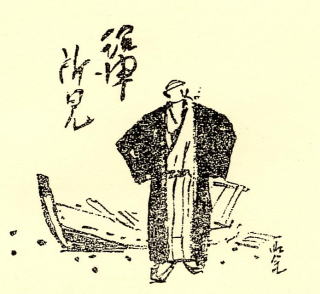 さて金一円三拾銭也の宿泊代を支払う、そして千本松原が見ながら徒歩で出かける、町を右へ左へといつくか曲がって沼津公園から抜けてごろ石の海岸へ出る。 さて金一円三拾銭也の宿泊代を支払う、そして千本松原が見ながら徒歩で出かける、町を右へ左へといつくか曲がって沼津公園から抜けてごろ石の海岸へ出る。
松の枝振りが見事なのが第一に目を奪う、そしてこれ等の松が密生して西に向かって茂っているのが紺碧の海と好対照をしている。天城の裾が断崖をなしている駿河湾これを背にした海岸の砂地に置いてある幾つかの漁船がよろしい、人力で漁獲にゆく櫓漕ぎの時代なので今の発動機と異なって中々に味な形なのだ、従ってそれ等のもので私の写生帳は満たされてゆく、夕べの不快をここで一掃した感じだ。
Observations in Numazu
Kenichi
|
After paying 1.3 yen for the stay, I started the walk while admiring Senbonmatsubara
(thousand pine trees). I made several
turns to left and right, went through Numazu park and arrived at a beach of
boulders
The first
thing my eyes caught was the wonderful shapes of pine trees. And these pines, growing densely and all
leaning to west, made marked contrast with the deep blue ocean. The base of Mt. Amagi forming a cliff into
Suruga bay, together with several fishing boats left on the sand beach in
front, looked rather attractive. These
fishing boats were man-powered and had a nice shape with a Japanese skull, not
like the ones with a motor we see these days.
These scenes filled in my sketchbook and I felt the memory of the
previous night’s distasteful experience dispelled.
|
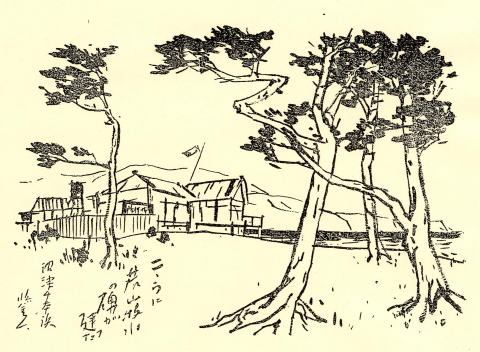
A
monument for Bokusui Wakayama (a Japanese poet) was erected around here.
Numazu
Senbon beach
Kenichi |
名家の庭
The house of a distinguished family
|
再び沼津の市内へ入ってから西への旅路を続ける、原の町へは平塚のS君からの紹介状にて明治天皇が東京の遷都の節お泊まりになった名家の庭を拝見することにしてあった。
早速お訪ねすると当主が直接に歓待される、愛鷹山と富士をバックにしたものでこれ等を上手に取り入れてある。そして右手寄りに赤松を生かした造園で、なまこ壁の蔵作りと共によい効果をあげている、人によってはあまりに常識的な庭園だと云うかも知れないが。 芝生のある庭の飛石と共に中々捨てがたいものであった。現在この家がどうなっているかしら、保存されている様願う。田子の浦から見た富士よりも私にはずっとこの庭からの富士が印象に残る、この家の名前を忘れてしまったのが残念だ。
|
I went
back to the Numazu city before continuing the journey to west. It had been arranged through the reference by
Mr S in Hiratsuka, that I would pay a visit to the house in Haranomachi, of a
distinguished family where the Emperor Meiji stayed on the way to move to Tokyo
from Kyoto.
The
owner welcomed me warmly. The house was
situated with Mt. Ataka and Mt. Fuji as the background and was designed to make
the most of them. The garden with a Japanese
red pine on the right hand, together with namako-kabe
(the wall covered with square tiles jointed with raised plaster), worked very
well, although some people may view the garden as too conventional. I thought there was something charming in the
design, including the stepping stones in the lawn.
I
wonder what happened to this house. I
hope it has been conserved. To me, Mt
Fuji viewed from this garden is much more memorable than that viewed from
Tagonoura. It is such a shame I cannot
recall the name of the family.
|
福禄寿頭のおやじ
A man looking like Fukurokuju
(the god of welfare and longevity)
|
鈴川から富士駅へ汽車の厄介で、あれから富士川の河原についた、ここから見ると富士の高さがしっかり解るので早速三脚を据えてスケッチを始める、一時間位で済んだので又西へのたびを始めようとすると、この河原へ始めから来ていた福禄寿の頭によく似たおやじが宿をどうすると聞くので、今夜はこの辺で泊まるのだと云うとそれなら俺しの家へ来いと云う宿屋の客引きかな、よしでは学生の身分を知ってのことだから宿料も安くしてくれると思って任せてしまった。だから岩渕の町へ二人ぶらぶら画の話やら風物の話やらして歩いた。岩淵の駅が間近い宿だが、このおやじが気に入ったので泊まる事にした。萬屋と書いた軒燈が入り口にある三階建の古い家だった、番頭から娘らしい女中、その母親らしい中年の女性等一家総出で迎える家庭的サービスにこっちは上機嫌だ。
|
| After
experiencing some train service trouble between Suzukawa station to Fuji
station, I reached the bank of the River Fujikawa. I immediately started sketching as it was
very easy to capture the height of Mt Fuji from this angle. Sketching took just over an hour and I was
preparing myself to continue the journey.
That was when a middle-aged man with the head shaped just like that of Fukurokuju, who had been hanging around
on the river bank before I arrived, asked where I was going to stay for the
night. When I said that I was intending
to stay in the area, he told me to come to his house. I wondered if he was actually a man who
touted for hotels for living but accepted his offer, thinking that knowing that
I was a student, he might give me a decent discount. We strolled to the town of Iwabuchi while
chatting about paintings and about natural scenery. The ryokan (Japanese-style hotel) was
situated near Iwabuchi station, but I kind of liked the man and so decided to
stay there. The three-storey old house
had a lantern bearing the name of the ryokan, ‘Yorozuya’ at the door. The warm welcome with the homely services by
the man and the maids, who seemed like the man’s daughter and mother, cheered
me up.
|
萬屋旅館「富士見の部屋」と画帳
“Room with the view of Mt Fuji” at Yorozuya and a sketchbook
|
夕食後、形通りの宿帳を持っておやじが来たがもう一冊不思議に分厚い帳面を持っている。さて名前、年齢等々を書き込んだ宿帳と引き換えに問題の帳面が出される。
五寸に一尺ぐらいの横綴りのもので用紙は炭酸紙であるから至ってお恥ずかしい代物だ、でおやじの希望はこれへ何でも絵を描けと云うのだ、つまり画帳なのだ、出発迄でよいと云うのでとりあえず食後でもと片隅の机上に置く、又曰く「その窓からあした早く起きて朝富士を見てくれ」と云う、つまり富士見の窓だ、そしてこの部屋は特別室の富士見の部屋とか云って居た、NO1の部屋らしい成程よく見れば夕べの沼津とは似ても似つかぬ上部屋で学生には一寸居心地がよすぎて落ち着けない。ここで一風呂浴びて例の画帳を一応拝見に及ぶ。第一に富士の画が書いてある。見れば和田英作先生のものだ。それから日本画、洋画の大家連の名画が、これは素晴らしいもの。紙質がもっと良い物であったらと思う。こんなに諸大家が書かれているにはこっちが参って気後れしてしまった。
おやじがさっき云った通り和田先生始め諸大家がこの宿へ何度となく来られてはこの窓からの富士を書かれていかれるそうで、そうした機会を重ねる度にこのおやじは画書きと話すのが何よりの慰めになっていったのだろう。こんな次第で私も十分優遇され宿料も沼津より余程安かった。
|
After
dinner, when the man brought the customary guestbook to my room, I noticed that
he was holding an unusually thick book.
I filled in my name and age, etc, in the guestbook, and as I gave it
back to him, he presented the book in question to me. It was about 1 feet by 0.5 feet and bound in
landscape format. The papers were of
embarrassingly poor quality. The man
asked me to paint on this sketchbook, telling me that I could give it back by
the time I depart. So, I put it down on
the desk in the corner, thinking perhaps I could paint something after
breakfast. But the man then said, ‘Could
you get up early tomorrow morning and have a look at Mt. Fuji through that
window?’ I realised that the window was there
to admire Mt. Fuji, and that was why the room had the name ‘Mt Fuji’,
indicating that it was a special room. Obviously, it was the best room in the inn,
and as I examined, it became clear the room was indeed a superior one which
could not have been any more different from that I stayed in previous
night. It was almost too good for a
student and made me somewhat uncomfortable.
After
having a bath, I had a look at the sketchbook.
The very first page, I found a painting of Mt Fuji by Mr Eisaku
Wada. In the following pages, I found
more marvelous masterpieces by famous artists in both Japanese and Western
painting styles. I only wished the paper
quality was a bit better. After seeing
the works of many famous names, I felt a little daunted to paint in the same sketchbook.
The
man told me that many eminent artists, including Mr Wada, had returned
repeatedly to this ryokan and painted
the pictures of Mt Fuji. He perhaps
became to find pleasure in talking to artists, through these visits. And that explained why I received such a
favourable treatment for the room charge of a lot less than that at Numazu. |
博賭の宿
Gamblers’ inn |
萬屋全員の見送りにこの宿を出る。おやじは町外れまで行こうと云う、かくて私は海辺に近い蒲原、由比の町々を過ぎて興津川のところまで来た、薩垂峠が断崖になって迫ったあの形と富士との対照が好いので三脚を構えてスケッチを始める。すると又此処でも一人の男が現れて何かと画の話を始めるのだ、今度のは人相が悪い福禄寿の顔ではない、そして今夜は己の宿に泊まれと、これも云いだした。断ると具合が悪くなりそうな気配がする。そこでまたまた興津の町へ二人連れで歩く事になった、有名な西園寺侯の座漁荘のあたりから清見寺へも参拝し、一応その宿へ行くことにしついてゆくと、興津の町も過ぎた、松並木に出るとすぐ左側の家に案内された、名前なんか見る気もしない宿屋で、料理屋で荒物屋でと云った店造りからして嫌な感じだ。帳場の側から上がって二階の裏座敷へ案内された。割合に新しい家だったから綺麗だが廉普請である。その眺望は案外好いのがまずまずと云うところだ。女中が来た、宿屋らしくない女中である、裏の田浦越しに東海道線の列車が通る、夕食を済ませる。この家に似合わず味は好い、今夜も早寝だ。
|
Everyone
at Yorozuya came out to see me
off. The man offered to walk with me to
the edge of the town. I walked along the
towns on the coast such as Kanbara and Yui, and arrived at River Okitsugawa. As the contour of the sheer precipice was
showing a good contrast with Mt Fuji, I set up a tripod and started sketching.
Again,
a man appeared and started chatting to me about painting. This man had a sinister look that was far
from fukurokuju. But again, the man invited me to stay at his
place. I had a sneaky feeling that it
was unwise to decline his offer. So, I
strolled, just like the night before, with the man to the town of Okitsu. I tentatively decided to follow him to his
place, passing near the famous villa of Sir Saionji called Zagyoso and visited Seikenji
temple on the way. Having passed the
town of Okitsu and the row of pine trees on the left immediately after that, we
came to his house. It was an inn but
also a tavern and hardware shop, which didn’t look impressive at all. So much so, I didn’t even check the name of
the place. I was taken to an upstairs’ backroom
through the staircase beside the reception desk. The house was relatively new and therefore
neat, but cheaply built. But as the view
was surprisingly good, I thought it was acceptable. The maid who came to serve didn’t look like a
maid of an inn. Trains were passing on
the Tokaido railway which ran on the other side of the rice paddies at the back
of the house. I had a dinner, which
turned out to be quite good, considering the impression of the house. I decided to go to bed early again.
|
夜中のドタバタ劇
Midnight Commotion |
それから暫くすると突然の音に目を醒ます。物が飛んで当たる音、壊れる音、女の声、鈍い人の足音が布団の中で私の胸を震わせる。こんな夜更けだ、逃げ出すわけにもゆかない。そして何時間か経ってやや物音が静まったのでほっとしたが大いに疲れた、そしてうとうと眠くなったのが夜明け間近だった。翌日は静かな朝、それに天気も上々、朝の食卓で女中に夕べの事を聞いたが駄目だ。想像してみるにここの女主人は博賭の妾である事、夕べはその旦那とそれらのグループが何かを行った挙句お定まりのごたごた騒ぎ。
以上で奥の二階に泊まった客の私がよい迷惑をしたのだ、そして翌朝出発する時この旦那が帳場の側で微笑みしながら薄気味悪く御世辞たらたら云うのに、「此処へ又来たら寄ってくれ」と、とんでもない隣に来たって寄るものかと自分に云う。こんな様な理由で面白くない旅路を続ける。
|
After
a while, I was woken by sudden noises.
The noise of objects hitting something and clashing, screeches of a
woman, heavy footsteps, all of which frightened me, still lying in bed. As it was the middle of night, there was no
way I could run off to somewhere else.
After a few hours of this, the noise level came down a little, by which
time I was totally exhausted. It was
almost dawn when I finally drifted off.
The next
morning was peaceful and beautiful. I
asked the maid about the midnight commotion, but she wouldn’t answer. I presumed that the hostess of this inn was
the mistress of a gambler and he and his gangs started arguing about something
which escalated into the kerfuffle – the same old.
It was my
luck that I stayed at the upstairs’ back room.
In the morning, the man gave me flattering remarks with a greasy smile
on his face and said to me, ‘Visit us again if you ever pass by’. I quietly told myself that even if I pass
right in front of this building, I would never, ever visit them. It was a bad start of the day, but I left
there to continue my journey.
|
清水 日本的風景の代表
Shimizu – A typical Japanese scenery |
嫌な気分での今朝は旅路だ、次の宿場は清水の町だ。成程ここには昔、有名な親分が居たのだが、夕べのは小形過ぎる。清水も発展して港が出来た、今日では日本の貿易港として有数なものとなったので自然異国的空気も強くなって来ていた。 ここまで来たのでついでに回り道をして竜華寺に寄る、あそこの眺めは箱庭の様だが日本の名所の一つに数えられる、富士の裾がみごとに見られるのと駿河湾の入江が非常にきれいだ。典型的だか日本的風景の代表とも云える。
|
I
started the journey in a bad mood. The
next post-town was Shimizu. Come to
think of it, there once was a legendary gamblers’ leader in this area, but the
one at last night’s inn was nowhere near his league.
Shimizu
had developed, and a port had been built.
As one of the biggest trading ports, it naturally had a more international
feel to it. As I came so
close to Ryugeji temple I made a slight detour to visit it. The view was rather like a miniature garden,
but it certainly was one of the scenic beauties in Japan with the superb view
of the base of Mt Fuji and fine-looking Suruga-bay. It is a quintessential Japanese scenery
albeit a little predictable. |
静岡七間町の宿と安倍川餅
An inn in Shizuoka Shichikencho and Abekawamochi (rice cake) |
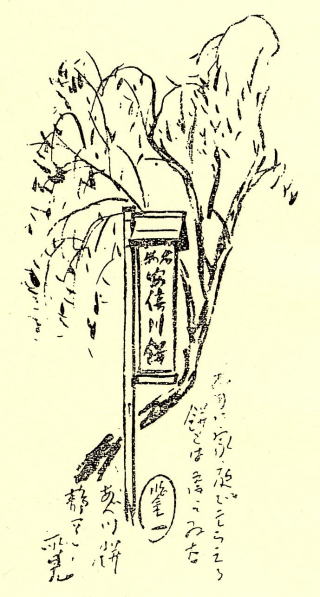 人気の好い静岡へは汽車で着いた、七間町と云う町へ入る。今日は交番のお世話で宿の取り定めをする。親切な巡査に世話してもらう。そして私の懐具合を十分参考にした上選んでくれたのだがその宿の名前を忘れてしまったのが残念だ。古い家で信用の厚い宿屋だった、七間町の通りにあった事を憶えている。店から渡り廊下でそれもスノコが置いてあるのを幾つか渡って、一番奥まった離れ座敷に通された、平屋建てなので感じがよく庭も十分あるので家庭的な感じが多い、この宿の娘さんらしいのが給仕に出て来る。だから食事も当方は少々上がり気味で話も碌々出来ないのだ。 夜分は気持ちに余裕が出来たので一寸町に散歩に出て見る。私が甘党の故かしるこ屋が目だって多いのに驚いた、夜店を一通り見物して宿に帰る今夜は久しぶりでよく眠れそうだ。勿論これは先刻の娘さんの好印象も原因だろう。静岡の泊まりは静寂そのものだった。東京出発以来久し振りで気持ちよい春を迎えた。気分が好いので今日一日を休養、そして市の内外を見物する。二日を過した静岡を出発安倍川畔であべ川餅の茶店に小憩、これからが五里の行程で山路もあるから、しかし休養をとってあるので足のほうは安心だ。 人気の好い静岡へは汽車で着いた、七間町と云う町へ入る。今日は交番のお世話で宿の取り定めをする。親切な巡査に世話してもらう。そして私の懐具合を十分参考にした上選んでくれたのだがその宿の名前を忘れてしまったのが残念だ。古い家で信用の厚い宿屋だった、七間町の通りにあった事を憶えている。店から渡り廊下でそれもスノコが置いてあるのを幾つか渡って、一番奥まった離れ座敷に通された、平屋建てなので感じがよく庭も十分あるので家庭的な感じが多い、この宿の娘さんらしいのが給仕に出て来る。だから食事も当方は少々上がり気味で話も碌々出来ないのだ。 夜分は気持ちに余裕が出来たので一寸町に散歩に出て見る。私が甘党の故かしるこ屋が目だって多いのに驚いた、夜店を一通り見物して宿に帰る今夜は久しぶりでよく眠れそうだ。勿論これは先刻の娘さんの好印象も原因だろう。静岡の泊まりは静寂そのものだった。東京出発以来久し振りで気持ちよい春を迎えた。気分が好いので今日一日を休養、そして市の内外を見物する。二日を過した静岡を出発安倍川畔であべ川餅の茶店に小憩、これからが五里の行程で山路もあるから、しかし休養をとってあるので足のほうは安心だ。
Abekawamochi
It was different from the ones made at home.
Kenichi |
I arrived
in the popular Shizuoka by train and went to a town called Shichikencho. This time, I arranged the lodging for the
night at a police box, with the help of a kind policeman. He chose the inn for me, giving a careful
consideration to my budget. Regrettably,
I forgot the name of the inn. It was an
old building but reputable inn, and on a street of Shichikencho, I recall.
From
the front, I was taken to the innermost annex room, by hopping over several
duckboards laid on the roofed passage.
It was a pleasant bungalow with a good-sized garden, which created an
homely atmosphere. A girl who presumably
was the daughter of the owner, came to wait on me at dinner. I was slightly flustered and struggled to
keep the conversation going. In the
evening when I felt more relaxed, I went out for a short stroll. I noticed, maybe because I have a sweet
tooth, a large number of Shiruko bar (serving sweet aduki bean soup with rice
cake pieces). By the time I had looked
around the night stalls on the streets and went back to the room, I felt as if
I could sleep well for a change. Perhaps
the girl at the inn who left a good impression helped my good mood, too. The night at Shizuoka was very quiet.
For
the first time since I left Tokyo, I awoke to a lovely spring day. As I felt so good, I decided to have a day’s
rest and look around the city. After two
days, I left Shizuoka, stopped for a short break at a tea house on River Abekawa
which served Abekawamochi (rice cakes
coated with roasted soy bean powder).
This was going to be the day to cover over 12 mile on mountainous road
but I had had a good rest and I expected my legs to be able to cope with it. |
宇津の山越え道
Cross-mountain road in Utsu |
安倍川を渡ると道は大きく右に回って青葉の香る山狭にかかる、とろろ汁で有名な吐月峰等を経て蔦の細道の入口を左手に見付ける。高さ三、四尺の表示杭に蔦の細道口と書いたのが建っていて巾三尺程の路が草むらの中に消えている。
これが上古の宇津の山越え道であって古詠が多い
するがなる宇津の山辺のうつつ身も
夢にも人にあわぬなりけり
宇津の山さこそはかねて聞きしかと
かすみをわたる蔦の細道
細道や蔦の葉うらの閑古鳥
ここを過ぎて暫く行くとみちはいよいよ山にせまり空気も冷えて来た様に感じられる。やがて芝居でも有名な宇津の谷峠に近い山間になってそこの小部落に入った。ところが中型の犬が一匹吠えてついて離れない。峠の下に出来た隋道の入り口に近いところまで来てやっと元の方へ引き返していった、この間十数分はかかったろう。土地に人に聞いたら私が洋服を着ているからだと云う、学生服でも洋服には違いないのだ。その頃はここらを洋服で歩く人間が余程珍しかったのだ。犬に気をとられて本職を忘れた。さて旧道は竹薮が一面に生えて居るので到底峠道は越せないから真下を貫いた隋道を行く、そして西口に出た。成程この辺の様子は気味が悪い、古い地蔵堂らしいものが、苔蒸す杉の木立に囲まれて建っていて薄気味悪く凄い。宇津の谷峠の舞台面そっくりの感じである。そして薄ネズ色に粉をふいた木地の鼠格子と破れ障子は昼間とは云え不安を感じさせずにはおかない、もう一度峠を振り返る。
|
After
crossing River Abekawa, the road followed a large sweep right and then entered
a gorge with fragrance of greenery.
Passing such places as Mt Togeppo, famous for tororo-jiru (grated yum soup), I found an entrance to the ancient Tsutanohosomichi (ivy lane). I saw a 3-4 feet signboard that read ‘To the Tsutanohosomichi’ and an approximately 3
feet-wide lane disappeared into the grassy area. This used to be the route to cross Mt. Utsu
in ancient time, and many poems have been written about it.
Passing
this point, I continued the route which took me closer to the mountain and the
air began to feel much cooler. I arrived
at a ravine near the Utsunoya pass, a famous setting for a play, and entered
into a hamlet. A medium size dog
followed me while barking and wouldn’t give up.
I had nearly reached the entrance of a tunnel built under the peak, when
he finally turned back, after some ten minutes.
According to the local person I came across, the dog barked because I
was wearing western clothing. What I was
wearing was actually a student uniform, but I must accept it wasn’t a
traditional Japanese attire. Back then,
it was that rare in that area to see someone who was walking in the ‘western’
clothing. Thanks to the dog, I lost focus
and forgot about the purpose of the trip for a while.
The
old road was like a bamboo grove and made it impossible for me to follow the
pass and so I took the tunnel that goes right underneath the pass. I came out on the west side of the tunnel which
was eerie. An old Jizo (the guardian deity of children) shrine or something similar
stood among the Japanese cedar trees covered in moss. It looked spooky and disturbing. It actually looked just like the stage set
for a Kabuki act titled the ‘Utsunoya Pass’. Finely latticed, chalky grey wooden sash with
torn paper screen made me feel unnerved, even in the broad daylight. I turned to have another look at the gorge.
|
岡部の茶店
A teahouse in Okabe |
ここから道は少しずつ下りになって岡部の町になる、細く長い一と列びの町がくねりくねって西へ延びているこの町は、人通りも稀な沈黙の町と云いたい位静かであった。そして町家が絶えると又松並木の平らな道になる。お昼も過ぎているからこのあたりで一休みしてご飯にしよう。こう思ってゆくと幸い松並木に一軒の茶店があったので腰を下ろす、広重の版画の人物になって。ここは原子鮪で有名になった焼津から丁度西北に位するところだ。茶店のお婆さんが何が好きか、鰹の刺身でご飯は如何だと云う、時は今5月だピッタリと来た、それを注文する。白米のご飯を丼に盛ってくれたので生姜醤油でこれをやったものだ。
松吹く風は五月の若葉を渡って暖簾を揺るがすと云う理でこの味千両だ。縁台の赤は木綿でも、結構藤棚は新緑の葉を光らせているし、田浦ではもう苗を植え付けている。見渡す空は真青で高い、こたを背景にした鰹丼の味は恐らく天下一品だと思う。私はお婆さんに十分感謝して御茶代を含めて金五十銭也を渡してここを立つ。そして一寸水郷を思わせる藤枝の町へ入って汽車に乗る。五里の道は少し疲れた。
|
From the
point on, the road sloped down gently until it reaches the town of Okabe. The town consisted of a single long and
narrow row of buildings that stretches to west and full of twists and turns and
was so deserted that it should have been called the town of silence. When the row of houses ended, a row of pine
trees began again along the flat road. I
was walking on thinking about the lunch break as it had passed noon, when I
luckily came across a tea house on an avenue of pine trees. I sat on the stool as if I was a character on
Hiroshige’s print. This town is located in north-west of Yaizu, which would later
become associated with ‘atomic tuna (exposed to radiation in Bikini atoll) scandal’.
The old maid at the tea house asked what
I would like and suggested slices of raw bonito and rice. As it was May, just the right season for
bonito, I decided to follow her suggestion.
She served white rice in a large rice bowl which I had with the fish
with soy sauce and grated ginger.
It was just
like the Japanese expression that ‘the breeze through pine trees touches on
young leaves of May and quivers the Japanese half curtain at shopfront’, and
that enhanced the taste no end. The red
cloth covering the bench was only cotton but fresh green leaves on wisteria trellis
were shining, while the rice paddies had already had young rice plants. The sky was bright blue as far as the eye can
reach. With these as the backdrop, the bonito
rice bowl tasted simply priceless. I
sincerely thanked the old maid and handed half a yen including some tip before
setting off. I walked to the town of Fujieda
that gave me the illusion of a riverside district and got on a train. I felt a little tired after walking some 12
miles.
|
島田の宿場其の一
Post town of Shimada, Part 1 |
島田で下車、朝顔の物語で有名な大井川の渡し場である島田の宿場へ今夜は泊まる事にした。駅から島田の町の中央部へ、それを左に曲がって大井川の方へと歩いて行くと右側に一軒の古びた宿を見つけた。今夜は何かの参考にもなろうからと、この宿に定めて商人宿と書かれた行燈のある店先から、そして先ずは二階のお部屋へと案内される。ところが汗とあぶらで妙な臭いのする浴衣を出されたがこれから不安が始まってきた。風呂場に行く。裏の方にある小さい風呂場はすでに陽が暮れかかっていたので灯りがついている。これがなんと石油ランプ灯なのだ。湯気で暗い灯りはなお暗く、流しの板が朽ちかかっているらしく、柔らかくくぼむのだ。こんな理由で風呂等は入るどころかそのまま部屋に戻り、口実を作るのに大骨を折った上、ようやくここを飛び出した。
|
| I got off
the train at Shimada and decided to stay at the post town with a ferry crossing
River Oigawa, which is famous as the setting for a Japanese ballad drama titled
‘Asagao Nikki (Diary of a morning glory)’.
I headed for the town centre from the station and then turned left
towards the River Oigawa only to find an old inn on the right-hand side. I thought it might be useful for a reference
and decided to stay there. I was guided
from the front of the inn where a paper-covered lantern with the writing
‘Itinerant traders’ inn’, to the upstairs room.
However, when I was presented with a yukata
(informal cotton kimono) that smelled sweaty and greasy, I became less certain
about my decision. I went to the
bathroom. It was already dusk and the small bathroom at the back had a light on.
To my surprise, it was an oil lamp that was lighting the bathroom. The dim light looked even dimmer by the steam
of the bath and the floor of the showering area next to the tub sank under
foot, indicating it was half rotten. I
gave a miss to the bath and went back to the room, and making some elaborate
excuses, I finally ran away from the inn.
|
島田の宿場其の二
Post town of Shimada, Part 2 |
そしてもと来た道を宿を探しに歩く。土地の人に聞くと新築なったばかりの宿を教えてくれたので、本通の左側にあったその宿に行く、番頭が中々こっちの希望を、つまり泊めてもらえないのだ。安くしてくれと値切っては居ないから、多分私の格好から判断して危ないとでも思ったのだろう。東京を出て日数も経った事だから、汚れも目に付いてきたからと自問する。でもやっと話がついたので表二階へ、立派な部屋だ。中庭のむこうは大広間になっていて宴会が始まる様子だ。こっちに無関係、風呂を済まして、夕食も終え寝る事にして床を頼む。その頃から大広間は一段と騒がしくなって三味線も混じっての陽気さに到底眠られるどころではない。しかも土地っ子はこの騒ぎが大きくなるにつれ益々馬力をかける感じだ、と云うのは昔からここの大井川か゜川止めになる度に客が永く逗留する。そこで退屈してくる。遊ぶ方法が考えられる。だから土地っ子のサービスは必然的に上手になるとこう私は察したのだ。察しても眠られない。嘆いても仕様がない。自然に負かして眠られる時を待った。
|
| I turned
back on the road that I came to look for the night lodging. I talked to the locals who told me a place
that just had been built on the left side along the main street. When I arrived, however, the manager was
reluctant to accommodate my request, in other words, reluctant to offer a room
to me. As I wasn't haggling, it was
probably my appearance which alarmed him.
It made me wonder if after so many days since leaving Tokyo, I might
perhaps look a little filthy. Finally,
however, he agreed and gave me an upstairs front room. It was a fine room. There was an entertainment hall across the
patio, and it looked as if a party was about to begin. But it didn’t concern me. After having a bath and dinner, I asked for
the bed to be made. The noise from the entertainment
hall began to escalate around then. The lively
party noises combined with the sound of shamisen
(Japanese lute) hardly helped me to fall asleep. Moreover, the noise seemed to increase by
time. I imagined that every time River Oigawa
rose and the ferry was cancelled, the passengers were forced to stay for quite
some time, and those who became bored found the ways to entertain themselves,
and the locals became better at entertaining guests. My imagination didn’t help me sleeping,
however. But there was no point in
mourning. I just accepted the fate and
waited for sleep to come. |
小夜の中山
Sayo-no-nakayama |
翌朝例に依って寝不足を汽車で大井川を渡る、金谷で下車、直ちに街道筋に出ると登りになっていて登りきったところが金谷峠の頂上で、汽車は直下をトンネルで通過している。で、この峠を下ったところが小夜の中山で有名な夜啼石のそこまで来た。路の右側に置かれた丸味のある黒色の石である。その頃は石杭の側にぽつんと置かれてあったが、今では宣伝的に利用されて居る様な気がする。
|
| I took the
train to go over the River Oigawa with a sleepy head as usual. I got off at Kanaya and came onto the main
road which was on an uphill. At the top
of the hill was the peak of Kanaya pass and trains passed right
underneath. After going over the pass
and going down a little, I came to the famous Yonaki ishi (A stone that cries at night) in Sayo-no-nakayama. A roundish black stone sat on the right-hand
of the road. Back then, it was just left
near a stone pile but these days, it is used for advertising the area, I think.
|
弁天島
Bentenjima |
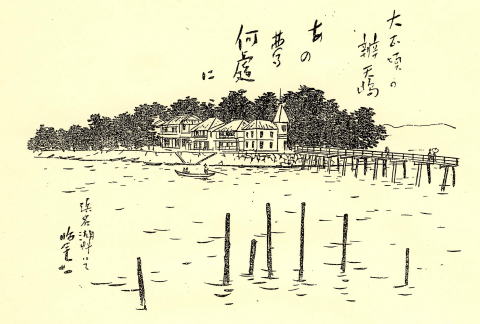
Bentenjima in Taisho era
Where has the dream gone?
By the Lake Hamanako
Kenichi
|
ここから数駅は記す程の事もないので浜松を過ぎ舞阪から弁天島まで来た。当時は戦争成金がこの地へ寄り集まったもので東と西の連中がここで贅を競った。そうした場所とは知りながらこの気分は悪くないから一泊する気になってMと云う旅館を選ぶ。海側の部屋へと案内された、遠州灘の波濤が座ってて眺められる上等な座敷である。気の弱い私は宿泊料が気になるから女中に確かめると金五円也である。少々勿驚りだ、箱根のホテルと同値段であ。勿論食事は付いている。場所柄だとあきらめて、夜はスケッチの手入れやら整理やらして、避暑気分にもなったりして寝床に入る。 翌朝は好天気。太平洋上の日の出を見ながら朝の食事一切を済ます。天気も好いのでもう一日滞在したい気分になるが宿賃が高いので先を急ぐ事にして店を出る。煙草がなくなったので聞くとここの隣が同業で且つ煙草の販売している。 主人らしい感じの人が出て来て煙草を出しながら貴方は美校の生徒ですねと云う、実は私の息子も音楽学校へ行っているので同じ上野の隣同士で妙に懐かしいと云うのだ、しまったこう云う主人なら何かと理解も持って呉れるだろうに。そうかこの家に泊まればよかったのに、、よし今晩こっちへ厄介になろうとこの主人に話し込むと、そればかりは御免蒙りたいと云う、商売道義で許してくれと云うのだ。泊まるならM館の方へどうぞと云う、聞いてくれない、残念だが弁天島での宿はこれでさよなら仕様。新居、二川、豊橋を経て蒲郡に一泊それから岡崎へ。この岡崎では遊郭が昔のままを残して居た事と、八丁味噌の倉作り、歴史で有名な矢作橋等が印象の深いものだった。
|
| A few
stations after this point offered nothing noteworthy and so I passed Hamamatsu
and travelled to Bentenjima via Maisaka.
Back then, this place attracted war profiteers from both the East and
West of Japan who competed to show off their wealth. I had known about this, but I didn’t think
there was anything wrong with staying here.
I chose a ryokan with
the name starting with the letter M for the night.. I was taken to a room with a
sea view. It was a superior Japanese
room from which the surges of the sea of Enshunada can be viewed from the
sitting area. Being a timid man, I was
worried about the tariff and so asked the maid who told me it was 5 yen a
night. I found it a little shocking as
it was the same price as for the hotel in Hakone. The rate was, of course, for the half
board. I accepted the room, thinking
that high price owed to the kind of place it was. Before going to bed, I touched up my sketches
and organised my luggage which made me feel as if I was on a vacation.
I woke to a
fine weather next morning. I had my
breakfast while watching the sunrise over the Pacific Ocean. With the weather being so good, I was tempted
to stay for another night, but alas it was too expensive a place for me to stay
on. So, I decided to move ahead and left
the ryokan. As I ran out of cigarettes, I asked where the
local tobacconist is. It turned out that
the next door was also a ryokan where
you could buy tobacco.
The man at
the ryokan who looked like the owner,
while handing me a pack of cigarettes, said to me ‘You’re an art student,
aren't you?’ and then told me that his son was a student of Tokyo Academy of
Music, which was next to the Tokyo School of Fine Arts where I was studying. I apparently reminded him of his son. I regretted that I hadn’t stayed at this place,
for the owner would have been empathetic. Then I thought I could stay this place for
that night. Sadly, however, he declined
my wish politely, telling me that it would go against business ethics. He was adamant that if I wished to stay in
this area for another night, I must stay on at the ryokan M. It was a shame,
but I had to say good bye to Bentenjima.
I travelled
through Arai, Futagawa and Toyohashi before staying in Gamagori, and then
headed for Okazaki. In Okazaki, I was
impressed by such things as the appearance of the old red-light district that had
been well preserved, the Haccho miso makers’ stonehouses and historically
renowned Yahagibashi bridge.
|
名古屋本町筋旅館 銭屋
A ryokan called Zeniya in Nagoya Honmachi |
名古屋へ急ぐ。ここは母の生地であるので親類が多い。どうしても訪ねばらならぬ家があった。それでも一晩は自由に宿屋の客になりたかったので第一夜は市の中心本町筋の旅館で銭屋というのに泊まる事にした。銭屋と云う屋号は大いに気に入ったここも巡査が選んで呉れたんだから堅い店なのだろう。女中が早速宿帳をと来た。さてこっちは久し振りで大都会へついたのだし人恋しい気分も出て来たところなので当の女中さんに対しても、ご機嫌を取る位だったから女中君大いに喜んだらしい。貴方は本当に学生さんかと不審がられたのも故なきに非ずだ。勿論うそ偽りなしの学生さんで、画を勉強する学校の生徒さんなんだ。そして東海道を京都迄の画行脚途中の立ち寄りとまあこんな具合に喋っていると、これは驚いた、一人二人と集まった宿の女中さん、七、八人が私を取り巻いていったものだ。内心大喜びの顔にはその色も出さず東京だよりでごまかして得意になっていると、この間東京から来た修学旅行の学生が泊まった時の話を女中達が聞いてくれと云いだした。話というのは、その一団が到着すると引率の先生が女中一同に向かって曰く「この生徒は皆東京の上流階級の子弟ばかりだから用向以外の話をしてはいけない」という堅いお触れ。女中さん連中は東京の話でも、と期待して居たところだから大いにご機嫌を損じてしまった。その後釜へ私がお着きになったのだからこっちがもてるのももっともだ。三角帽の横っちょに赤い房を下げ桐の徴章のついた学校帽だったと云う。階級意識の強かったその頃のようすがよく解って面白い。私はここで東京の明け暮れやら東海道中の所感を熱弁でやったので大変な喜びようだ。ラジオもテレビもなかった時代の一例だと思うと微笑ましい。こうして名古屋の第一夜を過ごした。
|
| I was in a
hurry to get to Nagoya. This is where my
mother was from and so I have many relatives in the area. I wanted the freedom of being a paying lodger
for at least a night in Nagoya, and decided to stay for the first night there
at a ryokan called Zeniya in the
Honmachi area, which was the centre of the city. I very much liked their trade name ‘Zeniya’
and as it had been recommended by a policeman, I thought it should be
trustworthy, too.
A maid
brought their guest book as soon as I settled in. Having arrived in a big city for the first
time in a while, I was feeling in need of company and was almost flattery to
the maid, which seemed to make her very happy.
So smooth I was being, the maid questioned me if I was really a
student. I told her that I was a genuine
art student and started telling that I was stopping there while on my sketching
pilgrimage along the Tokaido. To my
surprise, maids started gathering one by one and I was surrounded by 7 or 8 of
them in the end. I was pretty happy but
didn’t show it, of course, and kept telling them about things happening in
Tokyo, while feeling pleased with myself.
They then told me to listen to their story about the school trip group which
stayed the other day. According to them,
as soon as the group from Tokyo arrived, the teacher who was leading them gave
strict instructions to all the maids, saying ‘These students here are all upper-class
children from Tokyo, and so you’re not to talk to them unless it was for
essential matters.’ In fact, the maids
had been looking forward to asking them all the latest news from Tokyo, and so
this instruction very much annoyed them. And then I arrived, right after the
group. No wonder I was very popular. They described the school cap as the tricorn
with a red tassel on the side. This
tells you how class-conscious it was back then.
I rhapsodised about events and happenings in Tokyo and the observations
on the things that happened during my journey along Tokaido, which of course
pleased them no end.
This was
the way I spent the first evening in Nagoya.
It was the time when there were no Radio or TV. This episode brings
smile to my face.
|
名古屋の親戚
My relatives in Nagoya |
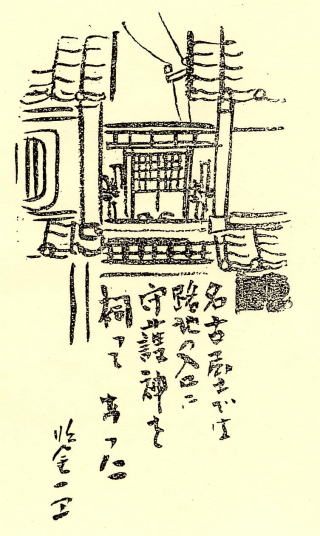 翌朝親戚を訪ねる。東京からの便りが沢山来ていたので一応これ等を整理する。さてこの主人は、待ってましたとばかりで今日の案内者となる。朝早くから出かけて先ず熱田さんから始めようと来た。熱田さんは説明する迄もないので、あの辺りに残されてあった古い港の様子を記してみる。昔桑名へ七里の渡し場であったこの地は岸壁に小柄な燈明台があった、それがちゃんとそのままの姿で残されてあった。そして近くには船着場特有の旅館が何軒かあったがその一軒は立派なもので御用宿の大看板とともに御定宿の木暖簾に諸大名の名が欄間にぎっしり懸けられていたし、その家の構造も宮造り風に出来ていたのが印象深い。だから夢を追うようにこれ等を眺めていると止めどがない。親戚の親父が次の見物先を、と急ぐ。一日名古屋の郊外迄も見歩いた揚句、大須近くの茶亭に夕方客となる。名古屋美人も現れる豪華さに学生のこっちは吃驚したが、これが何とおやじの馴染みだったので後味が悪く、帰り路で今夜のところは家へは内密でと来た。こんな味まで味あわされたのが積もったからでもあろう、胃を害ねてしまった。 翌朝親戚を訪ねる。東京からの便りが沢山来ていたので一応これ等を整理する。さてこの主人は、待ってましたとばかりで今日の案内者となる。朝早くから出かけて先ず熱田さんから始めようと来た。熱田さんは説明する迄もないので、あの辺りに残されてあった古い港の様子を記してみる。昔桑名へ七里の渡し場であったこの地は岸壁に小柄な燈明台があった、それがちゃんとそのままの姿で残されてあった。そして近くには船着場特有の旅館が何軒かあったがその一軒は立派なもので御用宿の大看板とともに御定宿の木暖簾に諸大名の名が欄間にぎっしり懸けられていたし、その家の構造も宮造り風に出来ていたのが印象深い。だから夢を追うようにこれ等を眺めていると止めどがない。親戚の親父が次の見物先を、と急ぐ。一日名古屋の郊外迄も見歩いた揚句、大須近くの茶亭に夕方客となる。名古屋美人も現れる豪華さに学生のこっちは吃驚したが、これが何とおやじの馴染みだったので後味が悪く、帰り路で今夜のところは家へは内密でと来た。こんな味まで味あわされたのが積もったからでもあろう、胃を害ねてしまった。
A patron saint was enshrined at
the entrance of an alley
Kenichi
|
I visited
one of my relatives next morning. Many
letters sent from Tokyo were waiting for me and so I dealt with them
first. The man of the house looked very
keen to show me around the area and volunteered to be my guide for the
day. As soon as we left the house early morning, he suggested that we should
start with visiting Atsuta Shrine. As Atsuta Shrine doesn’t need any
explanation, I will describe the old port conserved in the area. This used to be the port for the Shichiri-no-watashi (17-mile ferries)
with a small lighthouse on the quay. And
it was preserved as it used to be. There were several ryokans with the appearance unique to the wharf in the adjacent
area. One in particular had an imposing look and had
a large signboard that indicated the Shogunate’s patronage, while on the wooden
half curtain at the door was marked with the ‘Official inn’ sign. On the balustrade, countless wooden panels
with feudal lords’ names on them were hung.
The structure of the building itself was the shrine style construction
and was impressive. I could have stood
there looking at these in a dream-like state forever. However, my relative rushed me to more places
to visit. We looked around Nagoya,
including the outskirts, all day, and stopped at a tea ceremony house near Osu,
early evening. It was such a grand
entertaining involving a beautiful woman, which astonished me, who was only a
struggling student. It then became
apparent that my relative was her ‘regular customer’ which made me feel
awkward. On the way home, the man asked
me to keep what happened that evening to myself. It was probably due to the stress I felt by
such an unpleasant experience, I ended up developing a stomach upset.
|
鈴鹿神社
Suzuka Shrine |
翌日は名古屋城を見物する予定も取りやめて此所を出発、四日市、桑名を汽車にたより、亀山の宿に着いた。夜も翌朝も名古屋の毒気で食事が通らない、従って亀山での宿代は泊まり代のみの一金四十五銭と云う廉価で済んだ。亀山から坂ノ下、関、鈴鹿と、伊勢から近江路への旅を続けてゆく、関と云う町は鈴鹿峠手前の阪路に連なる細い町並みで、好い風景画になる。そしてこれから昇り路の鈴鹿峠迄数里は実に淋しく白い路筋の、行き交う人とて、たった一人の巡礼だけだった。そして左手に見ゆる伊勢特有の起伏の強い山の形が何か不思議な神経を揺り起こす。やがて有名な鈴鹿峠の直下についた。見上げれば古杉に囲まれた此処に鈴鹿神社がある。その暗い木陰の一番高いところに一塊の岩があって、その頂上に注連縄が飾られた鏡岩が木陰を通して空を映しているのがほんとに薄気味悪く、道はこれを巻く様に曲折して昇ってゆかなければならないのだ。さっき通った関の町が、もう少し近かったら戻ってしまいたいと思った。天狗が出てきそうな感じとはこの事だろう、鳥の羽音にも神経をたたかれる。
|
| I cancelled
the plan to visit Nagoya Castle next morning and left the house. I used the train to Yokkaichi and Kuwana and
arrived at the inn in Kameyama. I
couldn’t eat anything that evening and the following morning, thanks to the toxic
experience in Nagoya. But because of
that, the inn in Kameyama charged me only 0.45 yen, without the meals. From Kameyama, I continued the journey
through Sakanoshita, Seki and Suzuka, and then from Ise to Omiji. The town called Seki consists of rows of
houses along a narrow street that lead to the slope just before the Suzuka pass
and make a good landscape picture. After
that, several miles of uphill to the Suzuka pass was a white deserted
road. I encountered only one pilgrim on
the road. The very undulated contour of
mountains, unique to the Ise area, seen on the left, excited the nerves in a
strange way. Soon enough, I came to the
point right beneath the famous Suzuka pass.
Looking up, I found the Suzuka Shrine surrounded by old ceder
trees. There was a cluster of rocks at
the highest point in the dark shadow of the trees and at the top of it, a
mirror rock with Shimenawa (sacred rope) around it. It reflected the sky through the shadow of trees
and looked truly ominous. I was facing
the ascending road that wound around this particular point. I thought that if only the town of Seki was a
little nearer, I would turn back. I was
half expecting a goblin to show up. Even
the flapping of bird wings unnerved me. |
鈴鹿峠八丁二十七曲がり
Suzuka Pass - Haccho Nijushichimagari |
足元ばかり見つつ登れとばかりようやく二十七曲がりを頂上に出た。木の下闇の路から急に明るく拡げられた眼界のここが伊勢一帯を望める鈴鹿に頂きなのだ。遠く鳥羽あたりの海外線迄霞んで見えるここには一軒の茶店があった。それも掛茶屋程度ではなく、古びて豪荘なもので、その昔、伊勢詣りに江戸に、京都に、ここを通る旅人の全部がこの店に立ち寄っていったのだと、老婆が話してくれる。ゆであずきを啜りつつ腰掛けている縁の厚い角が丸く磨り減っているのを見ても如何に多くの人々が立ち寄って行ったがが解る。そして巾の広い欄間には煤けた板暖簾が一面に掛けてあって諸大名の名が読まれた。老婆は遠い昔を思い出す様にいろんな話を話して呉れた。前の道路をへだてた空地にはこいのぼりが六月の風に揺らいでいる。暫くするとさっきの老婆が孫らしい男の子を抱いて私がスケッチしている側に出て来た。そして取り残されたこの等も近く峠の下にトンネルが出来るからやがて廃道になるのだと云う。
|
After going
up the slope looking at nothing but my own feet, I finally reached the end of the
nijushichimagari (27 bends). From the
darkness in the undergrowth of woods, the views opened up suddenly. This is the very end of the road and the peak
of the Suzuka, looking over the entire Ise area. There was a teahouse where the coastline of
Toba could be seen in the distance through mists. It was not just any roadside teahouse, but an
old and sumptuous one. An old lady told
me that all travelers who passed this point on the way to worship at the Ise
Shrine, to Edo (Tokyo) or to Kyoto, stopped at the teahouse, a long time
ago. I observed the worn and rounded
corner of the heavy wooden bench that proved the number of people who visited
here, while enjoying the sweet aduki beans.
Countless sooty wooden panels with feudal lords’ names on them were hung
across the wide balustrade.
The old lady told me many stories reminiscent of
the olden days. Carp streamers were
flying in the June wind in the vacant land on the other side of the road in
front of the teahouse. Later, when I was
sketching, the old lady came to me holding a toddler, presumably a grandson, in
her arms. She told me that the rest of
the road here would be disused one day, as a tunnel was due to be built beneath
the pass. |
乗合馬車
A Stagecoach |
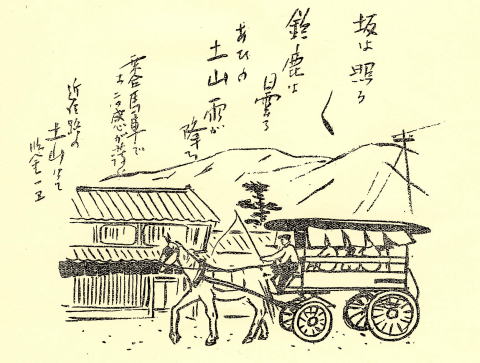
‘Sun shining on uphill, clouded
over Suzuka, rain falling Tsuchiyama that lies inbetween’
On stagecoach, the nuance is lost.
In Tsuchiyama along Omiji route.
Kenichi
|
次の駅である土山を出る乗合馬車は午後三時限りと聞かさ聞かされ急ぎ足で蟹坂部落を通過して、やっと土山の宿場に着く、すると盛んに豆腐屋の鳴らすラッパと同じ音色で吹いている。もしかすると乗合が出るのではないかと駆けつける。間に合ってほっとする。馬車はゆるりゆるりと土山を出発して次なる水口へと下ってゆく
坂は照る照る 鈴鹿は曇る
あひの土山雨がある
の馬子唄を思い出すが、この馬車てゆられてではピッタリ来ない。
この馭者と心安くなったので名所話や、世間話を聞かしてもらいながら夕方近く水口の町に着いた。
|
| I was told
that the only stagecoach departing from Tsuchiyama station, which was my next
station, leaves at 3pm. And so, I
hurried to the hamlet of Kanisaka and arrived at the post town of Tsuchiyama. There was the furious sound of bugle just
like that of tofu venders’ bugle, which made me wonder it might signify the
departure of the stagecoach. So, I ran
and caught it. I was very relieved that
I got on just in time. The coach left
Tsuchiyama very slowly and followed the road to Minakuchi, the next station.
The journey
reminded me of the lyrics of Suzuka
Magouta (horsemen’s song), singing about the sunny uphill, cloudy Suzuka
and rainy Tsuchiyama. But travelling on
the stagecoach hardly evoke the nuances feelings described in the horsemen’s
song.
I became friendly with the coachman who told me the stories about the noted
places and made small talk until we arrived at Minakuchi in late afternoon.
|
水口の宿
An Inn at Minakuchi |
彼から聞いた宿に真っ直ぐ行って客となる。ところが翌朝早く宿の番頭がオヅオヅとは入って来て、駐在所の巡査がお目に懸かりたいが此処に通しても好いからと云う。兎に角、諾を与える、四十位の小太りの巡査が入って来た。君は学生の様だか真実か?と来た。学校からの証明書を持っていたので簡単に話が解けた。夕べの残り餅菓子を出して話し合う。六月から夏休みになる学校はないと云う。後で宿の者がしきりに頭を下げて恐縮がる。夕べから何度も着たらしい、そして会わせろと言ってたのだそうで、人相が好くないばかりに、面倒を掛けたと笑った。
|
| I went
straight to the inn the coachman had mentioned and checked in. However, early next morning, the manager came
to my room and timidly told me the local policeman wanted to see me and would I
mind if he showed him in. Anyhow, I
agreed to see him. A chubby policeman
aged 40 or so, came into the room. He asked
me if it was true that I was a student although I looked like one. I had a student ID on me and so it easily resolved
the issue. I had a chat with him over
the leftover sweets from last night. I
explained that I didn’t need to go to the university from June onwards for the
summer vacation. A staff member at the
inn was extremely apologetic and bowed his head repeatedly. Apparently, the policeman had visited the inn
many times since the previous evening, insisting that he should meet me. I told him I was sorry to trouble them
because of my rough look and we laughed.
|
草津の小川
A small stream in Kusatsu |
ここを出て石部から草津へと出る。振り返ると昨日越えた鈴鹿の山々が朝日の影に遠く近江と伊勢の境として屏風のように連なって、空を区切っている。草津の小川でスケッチしていると第三の男が出て来た自分の家へ泊まれと云う、これは商売ではない、別荘を持っている京の人らしく画を愛する人だった。鮎のご馳走でもするからと云う。京までの旅も間近いから帰りに寄る約束で厚意を謝す。瀬田の唐橋、大津、三井寺等を見物して汽車で京へ着く。
|
| I left
there and headed for Kusatsu via Ishibe.
I took a backward glance and found Suzuka mountains making the shadow in
the morning sun and dividing the backdrop of Omi and Ise and the sky over these
areas, making the view look like a folding screen. When I was making sketches on the bank of a
small stream in Kusatsu, a man appeared and urged me to stay at his house – for
the third time. This time, his
invitation was not for a commercial reason.
He seemed to have a villa and just loved art. He even offered to serve sweetfish for
dinner. As the leg of journey to Kyoto
is pressing, I thanked him and promised to drop in on the way back.
I visited
Seta-no-karahashi (A bridge with Chinese motif in Seta), Otsu, Miidera temple
and so on before taking the train and arrived at Kyoto.
|
鴨川
River Kamogawa |
緑が濃くなった東山沿いの電車で一応三条通りへ降り立つ。落ち付いた京へ永い道中して来た気持ちは格別なものだ。三条大橋から見る比叡、愛宕の西山の、又は清く流れる鴨川を眺めているとは何とはなしに涙が湧いて来る。紅柄塗りの京の家々にしても、東京を出て二十日に近い旅路を過して来たのだから印象が強く、何もかも喜びだ。
|
| I took
the train that travelled along Higashiyama mountains of dark greens and got off
at Sanjo-dori to start with. Arriving in tranquil Kyoto after a long journey, I was filled with deep
emotion. Standing on Sanjo-ohashi bridge and admiring the west mountains
such as Mt Hiei, or looking down the passing clean water of River Kamogawa,
my eyes watered for no particular reason. Everything, even the
houses in Kyoto, coated with red iron oxide paint, felt impressive and
pleasing. |
偽学生
A fake student |
三条小橋を渡って少し歩いていると右側に一軒の理髪店があったがその真正面に掛けてあった大鏡に偶然私の姿が映った。店内が暗いからかえって明瞭に見えた。成程これでは偽学生にも見えたろう。髪は延びて学帽の外へぼやぼやと、中古の金ボタン服は肩のところが羊羹色のなりかけている。靴は踵の外側が磨り減っていっている。これではと我ながら感心してしまった。
|
| I was
strolling after crossing Sanjo-kobashi bridge, when I saw a barber on the
right-hand side. A large mirror that was
hung squarely fronting the street happened to catch me in reflection. The inside of the barber was dark and
enhanced the clarity of the reflection. No wonder I was suspected as a fake
student. The hair was long and messily
stuck out of my student cap and the shoulders of secondhand brass-buttoned
student uniform was fading into a rusty colour.
The heals of my shoes were worn outside. The view in the mirror was utterly staggering
|
帰京
Returning to Tokyo |
東京を出発する時に友人から紹介による麩屋町通りにあった甲賀屋と云う旅館に落ち付いた。京訛りの甘いアクセントに心がやわらぐ、そして一週間で京で過ごして画帳を充たした。帰りの汽車は特に昼間を選んだ。往きに見た山を、河を、町を見直しつつ帰京した。
|
| I settled
in at a ryokan called Kogaya on Fuyacho-dori street, which was
recommended by a friend before leaving Tokyo.
The gentle Kyoto accent was calming.
I stayed in Kyoto for a week and filled the pages of my sketchbooks. I chose to take a daytime train on purpose
and returned to Tokyo taking another look at the mountains, rivers and towns
that I had seen on the way. |
東禅寺
Tozenji Temple |
さあこれから現場の仕事に取り掛かるのだ。何しろ二十何間もの横長い代物だから普通の家では仕事が出来ない。幸い家の寺である高輪の東禅寺へ頼み込んでその座敷を借りる事にした。時の住職が大変好い人なのと私のおやじと仲が好かったので都合よく話が進んだ。再び帝国ホテルの食堂へ行き、原寸を計り直し、横縦の寸法と同寸法の下絵の紙を作った。そして食堂の真正面中央に富士を配し度い考えから巻物にした下画紙にその場所の印を附してから、もう一つ別の小下画を作ったものを土台として富士を中心に右手に東京までの、左手に京都までのを書き分けていって段々と構図が出来ていったのだ。さて東禅寺での製作も約二ヶ月で終了、若い頃の事なので大いに意気を揚げたものだ。
|
| Now, I was
about to start the painting on site.
Because the work was to be as long as 150 feet, it couldn’t have been
painted in the normal house.
Fortunately, Tozenji temple in Takanawa, which my family supported,
accepted my request to use their reception room. The then chief priest was a particularly nice
man and close to my father, which helped.
I visited the dining room in the Imperial hotel to take the measurements
again, and then prepared the paper for the preliminary sketch in the exact
dimensions. Based on the idea to place
Mt Fuji in the middle, which would be located in the centre of the wall facing
directly as you go into the dining room, I marked the position on the sketch
paper I was carrying rolled up. After
that, I made a smaller scale draft, which I used as the base for painting. With Mt Fuji in the middle, I painted the
route to Tokyo on the right half, and the route to Kyoto on the left half,
gradually working on their compositions.
The work at
Tozenji temple was completed in two months.
I was young and in very high spirits, then.
|
壁画完成
The completion of the mural |
経師屋の手に依って裏打ちをし、現場の壁にも同様下地を和紙で張り付ける等、準備も終わったのでいよいよ壁面の中央部に当たる富士山のところから右に左にと、はりだしてゆく、私は食堂の真ん中へ腰を下ろしてこの様子を見ていると何とも云えない亢奮が湧いてきて、側で同じく見ておられた林支配人と笑をかわしたものだ。東海道の行脚から始まったこの仕事もどうやら終わった。勿論所々に不満な点もあったが何とか纏め上げた事だけでもと、一人思ったものだ。
|
| Backing
material was applied to my painting by the paperhangers, and the wall on the
site had some Japanese paper applied on it as a lining. After finishing these preparations, finally
the painting was pasted on the wall from the middle section where Mt Fuji was
painted towards left and right. As I sat
in the middle of the dining room watching this process, indescribable
excitement overwhelmed me, and I exchanged smiles with Mr Hayashi, the General
Manager, who was watching the process next to me. I had somehow completed the work that began
with sketching tour along the Tokaido.
There were certain things that I wasn’t quite satisfied with the
painting, but I told myself that I should be satisfied by the fact I managed to
complete the project.
|
挿話
Some episodes |
ついでながらここで一つ二つにこれに連なる挿話を記したい。第一に氏名を隠された人から絵巻風に東海道を書いて欲しいと林さんを通じて、第二はこの食堂のキャプテン氏から二、三私に任せるからいいところを書いて欲しいと、第三は林支配人宅の子供部屋へ壁画を、それと駒沢ゴルフ場の全景図それに近く同ホテルで行われるある宴会場の入口を装飾して欲しいと、以上のような繁盛ぶりであった。
|
| I’m going
to add a couple of episodes that followed this project. First of all, I accepted the commission by
an anonymous person who, through Mr Hayashi, asked for the painting of the Tokaido
in a picture-scroll style. Secondly, the
head of the dining room asked for the painting of the highlights, whichever I
thought would be best. Thirdly, Mr
Hayashi asked for a mural for his child’s room.
He also requested the painting of the panorama view of Komazawa golf
course and the design of the entrance to the banquet hall for a party that
would take place at the Hotel. My
painting business prospered.
|
宴会場入口アーチ
Arch for the banquet hall entrance |
日限物の宴会の仕事を第一に取り掛かる。それは宴会場入口にエジプト風の画模様によるアーチを作る事だった。多分、これはゴルフの親睦会か優勝の記念式かである。ミイラ取りがミイラになったような話しから生まれた案で、宴会場のキャプテンだった仁羽さんもこのアーチをみて驚いたものだ。その上当日の式場へ引っ張り出された上に列席の面々の似顔絵迄も画かれさてしまった。その面々は時の有名人ばかりであって大した顔ぶれの集まりであった。
|
| The first
job following the Tokaido mural was a project for a party that was to last for only
a day. More specifically, my briefing
was to make an arch depicting the Egyptian motifs. I guessed it was a golfers’ informal social gathering or championship celebration
party.
The idea of Egyptian motif came from some ‘mummy hunters end up being a
mummy’ (i.e. the biter becomes bitten) joke and even the head of the banquet hall
was shocked when he saw the arch. I was
dragged into the party on the day and persuaded to paint the guests’ portraits
on the spot, too. The guests were all
celebrities of the time and the party certainly included an extraordinary
collection of people. |
駒沢ゴルフ場
Komazawa Golf Course |
次に林さんから呼び出されて、お宅へ伺うと今日はゴルフ場を見せるから一緒にきなさいと云う、そして君一寸済まないがこれを担いでくれとゴルフバックを肩にした。そしてとうとうゴルフ場を一周の後これがゴルフ場のクラブハウスだと赤松林の向こうの建物を指される。何処からでもよろしいこのゴルフ場を画いてくれと云われるそれは承知したが考えてみると今日はいつの間にかすっかりキャディをやらされてしまったのでぼうっとしたことである
|
| Following
that project, when I visited Mr Hayashi’s house on his request, he told me to
come with him to a golf course, as he wanted to show the place to me. He then politely asked me to carry his golf
bag. After going around the course with
me carrying his bag on my shoulder, he pointed to the building on the other
side of Japanese red pine woods and told me it was the clubhouse. He then asked me to paint the whole golf
course from whichever angle I liked, which I agreed.
Come to
think of it, though, I spent a whole day as his caddie without realising it –
How dim could I be!
|
帝国ホテル実績につづく
To ‘Imperial Hotel Interior Work’ page |
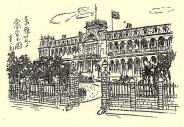
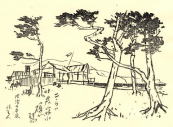
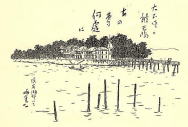

 そして同商店員に付添われて、山下橋側入り口から参入する事になった。とその時同行の店員の右手に何か木の札が見えるので 「それは何か」と聞きただすと 「これがないとホテルへ入れないのだ」と云うのである。
そして同商店員に付添われて、山下橋側入り口から参入する事になった。とその時同行の店員の右手に何か木の札が見えるので 「それは何か」と聞きただすと 「これがないとホテルへ入れないのだ」と云うのである。 平塚はずれの花水川に映る高麗山の緑の美しさ、大磯の虎と関連の深い粧阪(けはい)にかかる、昨年まで東海道線と交差していた踏切のすぐ右手、昇りきった右側に、一軒の茶店があった。ここの団子が美味しいからと云うので腰を下ろす、成程一寸はいけるが味より形が面白いので印象に残る。最もこれは東京でも見た事があるが、それよりも極めて小さい団子で五本の串に集めて焼いたものその名も粧団子と呼んでいた。(カット参照) この家は今も残っているのが汽車の窓からよく見える。勿論今は茶店ではないし代も変わっているだろう。
平塚はずれの花水川に映る高麗山の緑の美しさ、大磯の虎と関連の深い粧阪(けはい)にかかる、昨年まで東海道線と交差していた踏切のすぐ右手、昇りきった右側に、一軒の茶店があった。ここの団子が美味しいからと云うので腰を下ろす、成程一寸はいけるが味より形が面白いので印象に残る。最もこれは東京でも見た事があるが、それよりも極めて小さい団子で五本の串に集めて焼いたものその名も粧団子と呼んでいた。(カット参照) この家は今も残っているのが汽車の窓からよく見える。勿論今は茶店ではないし代も変わっているだろう。
 さて金一円三拾銭也の宿泊代を支払う、そして千本松原が見ながら徒歩で出かける、町を右へ左へといつくか曲がって沼津公園から抜けてごろ石の海岸へ出る。
さて金一円三拾銭也の宿泊代を支払う、そして千本松原が見ながら徒歩で出かける、町を右へ左へといつくか曲がって沼津公園から抜けてごろ石の海岸へ出る。
 人気の好い静岡へは汽車で着いた、七間町と云う町へ入る。今日は交番のお世話で宿の取り定めをする。親切な巡査に世話してもらう。そして私の懐具合を十分参考にした上選んでくれたのだがその宿の名前を忘れてしまったのが残念だ。古い家で信用の厚い宿屋だった、七間町の通りにあった事を憶えている。店から渡り廊下でそれもスノコが置いてあるのを幾つか渡って、一番奥まった離れ座敷に通された、平屋建てなので感じがよく庭も十分あるので家庭的な感じが多い、この宿の娘さんらしいのが給仕に出て来る。だから食事も当方は少々上がり気味で話も碌々出来ないのだ。 夜分は気持ちに余裕が出来たので一寸町に散歩に出て見る。私が甘党の故かしるこ屋が目だって多いのに驚いた、夜店を一通り見物して宿に帰る今夜は久しぶりでよく眠れそうだ。勿論これは先刻の娘さんの好印象も原因だろう。静岡の泊まりは静寂そのものだった。東京出発以来久し振りで気持ちよい春を迎えた。気分が好いので今日一日を休養、そして市の内外を見物する。二日を過した静岡を出発安倍川畔であべ川餅の茶店に小憩、これからが五里の行程で山路もあるから、しかし休養をとってあるので足のほうは安心だ。
人気の好い静岡へは汽車で着いた、七間町と云う町へ入る。今日は交番のお世話で宿の取り定めをする。親切な巡査に世話してもらう。そして私の懐具合を十分参考にした上選んでくれたのだがその宿の名前を忘れてしまったのが残念だ。古い家で信用の厚い宿屋だった、七間町の通りにあった事を憶えている。店から渡り廊下でそれもスノコが置いてあるのを幾つか渡って、一番奥まった離れ座敷に通された、平屋建てなので感じがよく庭も十分あるので家庭的な感じが多い、この宿の娘さんらしいのが給仕に出て来る。だから食事も当方は少々上がり気味で話も碌々出来ないのだ。 夜分は気持ちに余裕が出来たので一寸町に散歩に出て見る。私が甘党の故かしるこ屋が目だって多いのに驚いた、夜店を一通り見物して宿に帰る今夜は久しぶりでよく眠れそうだ。勿論これは先刻の娘さんの好印象も原因だろう。静岡の泊まりは静寂そのものだった。東京出発以来久し振りで気持ちよい春を迎えた。気分が好いので今日一日を休養、そして市の内外を見物する。二日を過した静岡を出発安倍川畔であべ川餅の茶店に小憩、これからが五里の行程で山路もあるから、しかし休養をとってあるので足のほうは安心だ。
 翌朝親戚を訪ねる。東京からの便りが沢山来ていたので一応これ等を整理する。さてこの主人は、待ってましたとばかりで今日の案内者となる。朝早くから出かけて先ず熱田さんから始めようと来た。熱田さんは説明する迄もないので、あの辺りに残されてあった古い港の様子を記してみる。昔桑名へ七里の渡し場であったこの地は岸壁に小柄な燈明台があった、それがちゃんとそのままの姿で残されてあった。そして近くには船着場特有の旅館が何軒かあったがその一軒は立派なもので御用宿の大看板とともに御定宿の木暖簾に諸大名の名が欄間にぎっしり懸けられていたし、その家の構造も宮造り風に出来ていたのが印象深い。だから夢を追うようにこれ等を眺めていると止めどがない。親戚の親父が次の見物先を、と急ぐ。一日名古屋の郊外迄も見歩いた揚句、大須近くの茶亭に夕方客となる。名古屋美人も現れる豪華さに学生のこっちは吃驚したが、これが何とおやじの馴染みだったので後味が悪く、帰り路で今夜のところは家へは内密でと来た。こんな味まで味あわされたのが積もったからでもあろう、胃を害ねてしまった。
翌朝親戚を訪ねる。東京からの便りが沢山来ていたので一応これ等を整理する。さてこの主人は、待ってましたとばかりで今日の案内者となる。朝早くから出かけて先ず熱田さんから始めようと来た。熱田さんは説明する迄もないので、あの辺りに残されてあった古い港の様子を記してみる。昔桑名へ七里の渡し場であったこの地は岸壁に小柄な燈明台があった、それがちゃんとそのままの姿で残されてあった。そして近くには船着場特有の旅館が何軒かあったがその一軒は立派なもので御用宿の大看板とともに御定宿の木暖簾に諸大名の名が欄間にぎっしり懸けられていたし、その家の構造も宮造り風に出来ていたのが印象深い。だから夢を追うようにこれ等を眺めていると止めどがない。親戚の親父が次の見物先を、と急ぐ。一日名古屋の郊外迄も見歩いた揚句、大須近くの茶亭に夕方客となる。名古屋美人も現れる豪華さに学生のこっちは吃驚したが、これが何とおやじの馴染みだったので後味が悪く、帰り路で今夜のところは家へは内密でと来た。こんな味まで味あわされたのが積もったからでもあろう、胃を害ねてしまった。